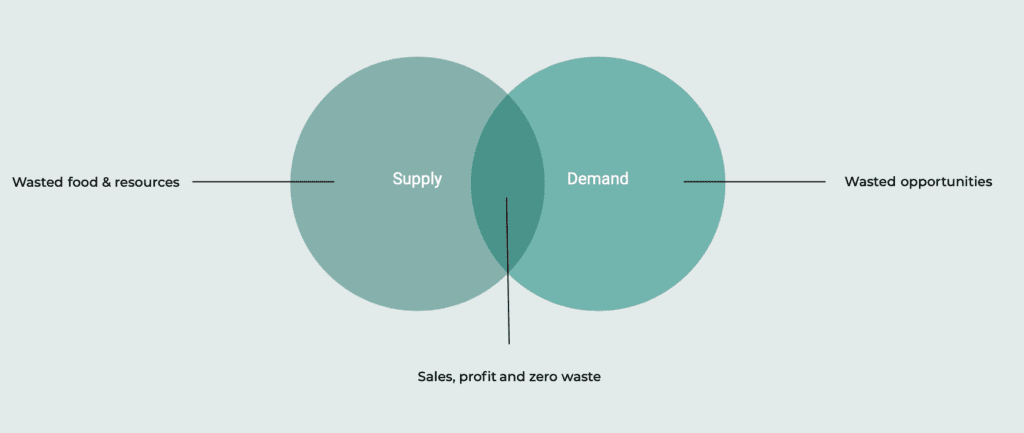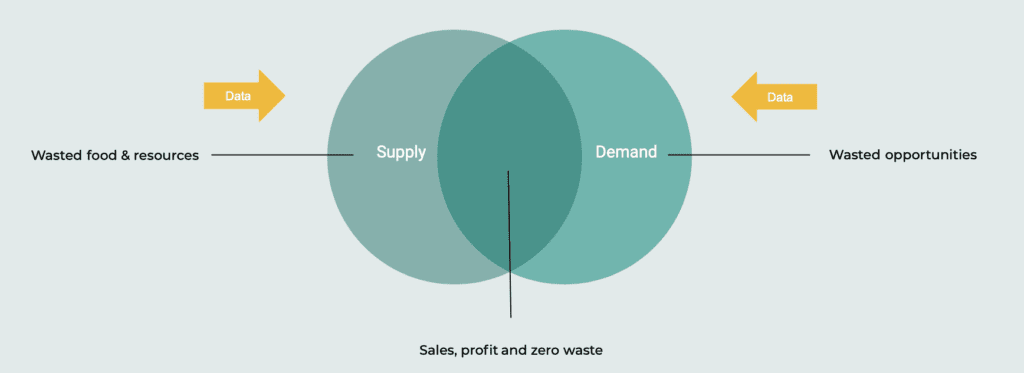By connecting marketing programs with geographic store and inventory data, Crisp is developing tools to help CPG brands meet demand and reduce (ad) waste.
The data gap
CPG marketing has long had a “last mile” problem when it comes to retail data. Data is instrumental in driving sales, production, and brand decisions, but once the product lands with a retailer, it’s hard to know exactly what happens next. It’s even more challenging to put retail data into a feedback loop that informs immediate and future decision-making. As a result, CPG marketers are often forced to make decisions based on incomplete data.
This has serious implications, for brands and beyond. Simply put, a lack of data in retail widens the gap between supply and demand. Let’s imagine the best case scenario: when supply exactly meets consumer demand, the system is operating perfectly, with the right amount of product in the right place to serve the customers who want it. But when this gap widens, you have either missed opportunities (there isn’t enough product to meet demand) or food waste (there’s more product than can move off of the shelves). Both of these outcomes are detrimental to businesses and to the environment.

Using marketing to align supply and demand
Crisp is working to solve this problem, connecting real-time data sources to help CPG companies match supply with demand. Data-driven collaboration has always been core to Crisp’s vision, with connectors that automatically ingest and aggregate data from the top 80% of U.S. retailers and distributors. From there, Crisp makes this data accessible in interactive dashboards or by piping data into tools that CPG brands rely on most, from cloud-based data warehouses to BI tools. And now, we’re expanding these connections to marketing applications, programmatically delivering store-level sales and inventory data into the hands of marketers.
Using geo-location data through GeoJSON code, Crisp will turn retail sales reports into geographic data that is immediately usable by marketing teams. By piping GeoJSON data into a Google Maps API, for example, we can help brands populate online store locators that automatically update when store locations change to help customers find their products. It can also feed directly into advertising programs, finally helping marketers bring precision to retail marketing efforts. Typically, brands had no choice but to advertise to a broad range of customers, wasting spend in areas where products weren’t actually carried or available. Now, brands can refine budgets on a granular level to target shoppers within a certain mile radius of select stores that they know are carrying their product. This has a tremendous impact on marketing ROI, and can go a long way toward helping emerging challenger brands succeed with limited resources. This type of targeted advertising can be carried out programmatically, saving staff time and avoiding human error. And as store availability and coverage changes (which it often does), up-to-date information flows seamlessly into advertising platforms, which will retarget based on the changes. Store locations aren’t the only data that can flow into marketing tools: any sales, inventory, pricing, waste tracking, on-shelf availability, forecasts, or expiration data that retailers or distributors track can be used to target marketing spend.
Precise geographic targeting can also help CPG teams unlock another age-old problem: proving the in-store impact of marketing spend. It can be hard to see how advertising translates to retail shelves, but by executing advertising with detailed precision, it allows marketers to closely monitor the impact on sales, velocity, and product SKU at a given store. It can even be used to A/B test different marketing strategies for select stores.
The Crisp platform uses signals from the supply chain, sales, and inventory to help food companies predictively match supply and demand in a way that eliminates the need for overproduction, over-delivery, and resulting waste. Responding to a surplus of product at a given store or distribution center, marketing teams can programmatically run advertising campaigns targeted at those locations to prevent spoilage and maximize profitability. And if demand is quickly growing or a promotion is underway at a given location, brands can monitor those impacts at the DC level, where data can trigger replenishment teams to deliver new shipments as efficiently as possible. As we align supply more closely with demand, we can get to a point where the supply chain not only meets the needs of the changing market, but eliminates food waste. And maximizes Return on Ad Spend.

We’re excited about the ways Crisp can help marketing teams leverage data to run highly effective campaigns that benefit companies, consumers, and the planet. To learn more about Crisp’s open-data platform, contact us for a demo. To stay tuned on the latest updates and industry insights, subscribe to the blog.